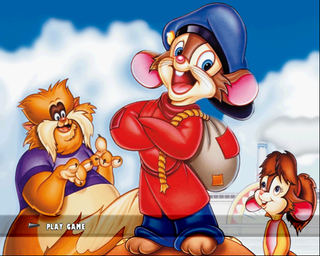An American Tail (PlayStation 2)
| An American Tail |
|---|
|
Developer: Data Design Interactive[1]
|
Despite being based off the 1986 animated film of the same name, the PS2 An American Tail game has very little to do with the movie itself, aside from Fievel being in it. Instead, it's a blatant clone of Super Monkey Ball and far from Data Design Interactive's first time doing so.
Contents
Sub-Pages
| Development Info |
Unused Graphics
PC Save Icons
Save icons for a PC version are present, but a PC version was never released.
Billy the Wizard Leftovers
Various models and textures from Billy the Wizard: Rocket Broomstick Racing are still present in the game's data.
Unused Text
The following text can be found in the executable.
Havok
------------------------------------- Havok Hardcore - Version(%d) Build(%d) Client version Base system initialized. -------------------------------------- Warning Havok keycode is invalid. Please check that you have entered it correctly in keycode.h If this problem persists please contact Havok.com for assistance.
Qhull Error
A Qhull error has occurred. Qhull should have corrected the above
precision error. Please send the input and all of the output to
qhull_bug@geom.umn.edu
Precision problems were detected during construction of the convex hull.
This occurs because convex hull algorithms assume that calculations are
exact, but floating-point arithmetic has roundoff errors.
To correct for precision problems, do not use 'Q0'. By default, Qhull
selects 'C-0' or 'Qx' and merges non-convex facets. With option 'QJ',
Qhull joggles the input to prevent precision problems. See "Imprecision
in Qhull" (qh-impre.htm).
If you use 'Q0', the output may include
coplanar ridges, concave ridges, and flipped facets. In 4-d and higher,
Qhull may produce a ridge with four neighbors or two facets with the same
vertices. Qhull reports these events when they occur. It stops when a
concave ridge, flipped facet, or duplicate facet occurs.
Qhull is currently using single precision arithmetic. The following
will probably remove the precision problems:
- recompile qhull for double precision (#define REALfloat 0 in user.h).
When computing the Delaunay triangulation of coordinates > 1.0,
- use 'Qbb' to scale the last coordinate to [0,m] (max previous coordinate)
When computing the Delaunay triangulation:
- use 'Qz' to add a point at-infinity. This reduces precision problems.
If you need triangular output:
- use option 'Qt' to triangulate the output
- use option 'QJ' to joggle the input points and remove precision errors
- use option 'Ft'. It triangulates non-simplicial facets with added points.
If you must use 'Q0',
try one or more of the following options. They can not guarantee an output.
- use 'QbB' to scale the input to a cube.
- use 'Po' to produce output and prevent partitioning for flipped facets
- use 'V0' to set min. distance to visible facet as 0 instead of roundoff
- use 'En' to specify a maximum roundoff error less than %2.2g.
- options 'Qf', 'Qbb', and 'QR0' may also help
To guarantee simplicial output:
- use option 'Qt' to triangulate the output
- use option 'QJ' to joggle the input points and remove precision errors
- use option 'Ft' to triangulate the output by adding points
- use exact arithmetic (see "Imprecision in Qhull", qh-impre.htm)
The input to qhull appears to be less than %d dimensional, or a
computation has overflowed.
Qhull could not construct a clearly convex simplex from points:
The center point is coplanar with a facet, or a vertex is coplanar
with a neighboring facet. The maximum round off error for
computing distances is %2.2g. The center point, facets and distances
to the center point are as follows:
center point
facet
p%d
distance= %4.2g
These points are the dual of the given halfspaces. They indicate that
the intersection is degenerate.
These points either have a maximum or minimum x-coordinate, or
they maximize the determinant for k coordinates. Trial points
are first selected from points that maximize a coordinate.
Because of the high dimension, the min x-coordinate and max-coordinate
points are used if the determinant is non-zero. Option 'Qs' will
do a better, though much slower, job. Instead of 'Qs', you can change
the points by randomly rotating the input with 'QR0'.
The min and max coordinates for each dimension are:
%d: %8.4g %8.4g difference= %4.4g
If the input should be full dimensional, you have several options that
may determine an initial simplex:
- use 'QJ' to joggle the input and make it full dimensional
- use 'QbB' to scale the points to the unit cube
- use 'QR0' to randomly rotate the input for different maximum points
- use 'Qs' to search all points for the initial simplex
- use 'En' to specify a maximum roundoff error less than %2.2g.
- trace execution with 'T3' to see the determinant for each point.
- recompile qhull for double precision (#define REALfloat 0 in qhull.h).
If the input is lower dimensional:
- use 'QJ' to joggle the input and make it full dimensional
- use 'Qbk:0Bk:0' to delete coordinate k from the input. You should
pick the coordinate with the least range. The hull will have the
correct topology.
- determine the flat containing the points, rotate the points
into a coordinate plane, and delete the other coordinates.
- add one or more points to make the input full dimensional.
This is a Delaunay triangulation and the input is co-circular or co-spherical:
- use 'Qz' to add a point "at infinity" (i.e., above the paraboloid)
- or use 'QJ' to joggle the input and avoid co-circular data
References
Games > Games by content > Games with hidden development-related text
Games > Games by content > Games with unused graphics
Games > Games by content > Games with unused models
Games > Games by developer > Games developed by Data Design Interactive
Games > Games by platform > PlayStation 2 games
Games > Games by publisher > Games published by Blast! Entertainment
Games > Games by release date > Games released in 2007
Games > Games by release date > Games released in July
Games > Games by release date > Games released in July > Games released on July 12
Games > Games by release date > Games released in July > Games released on July 13








